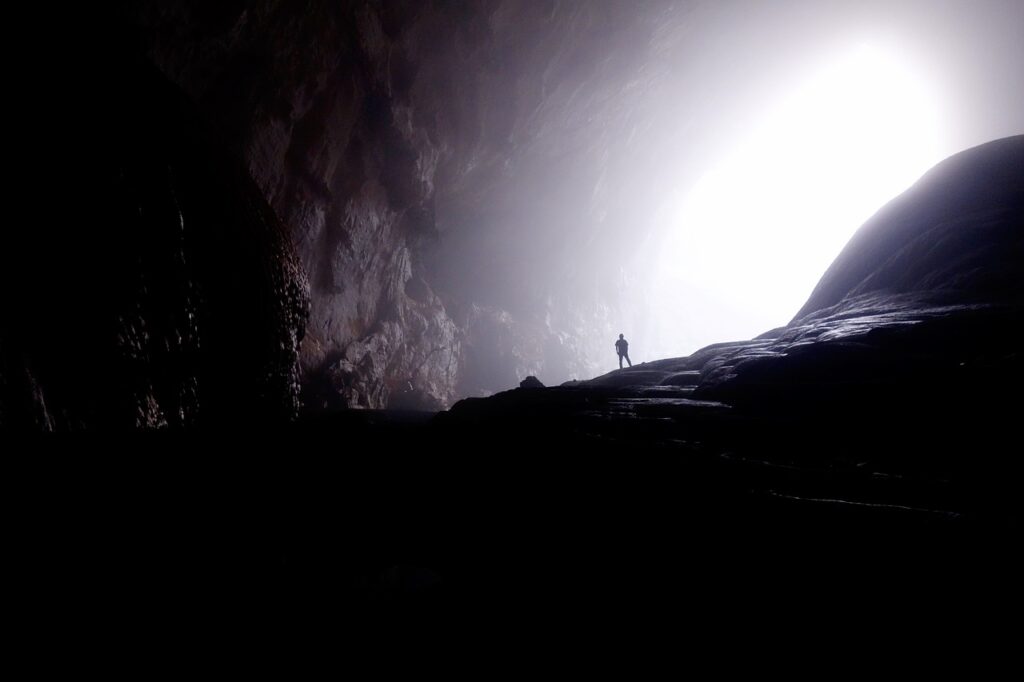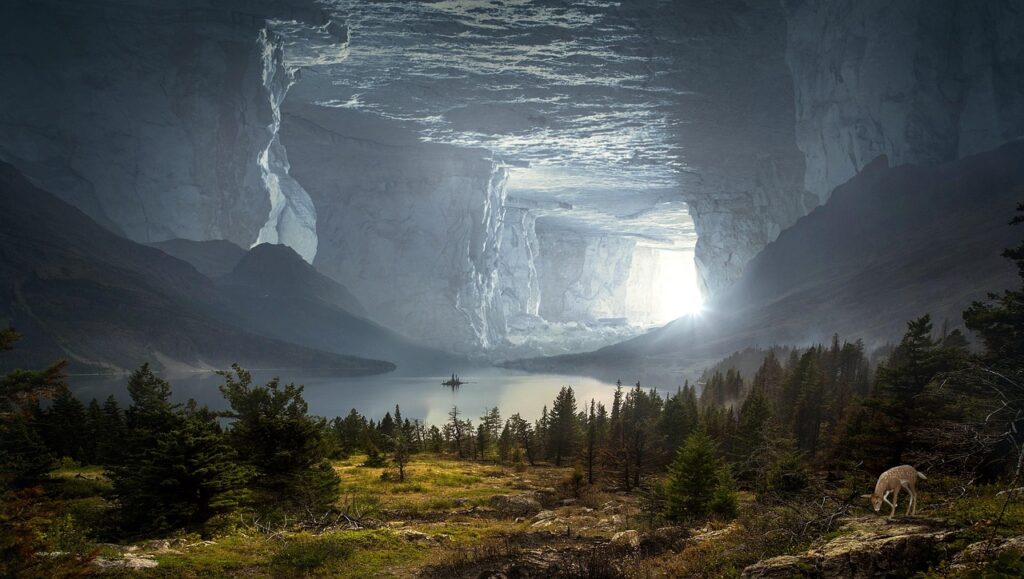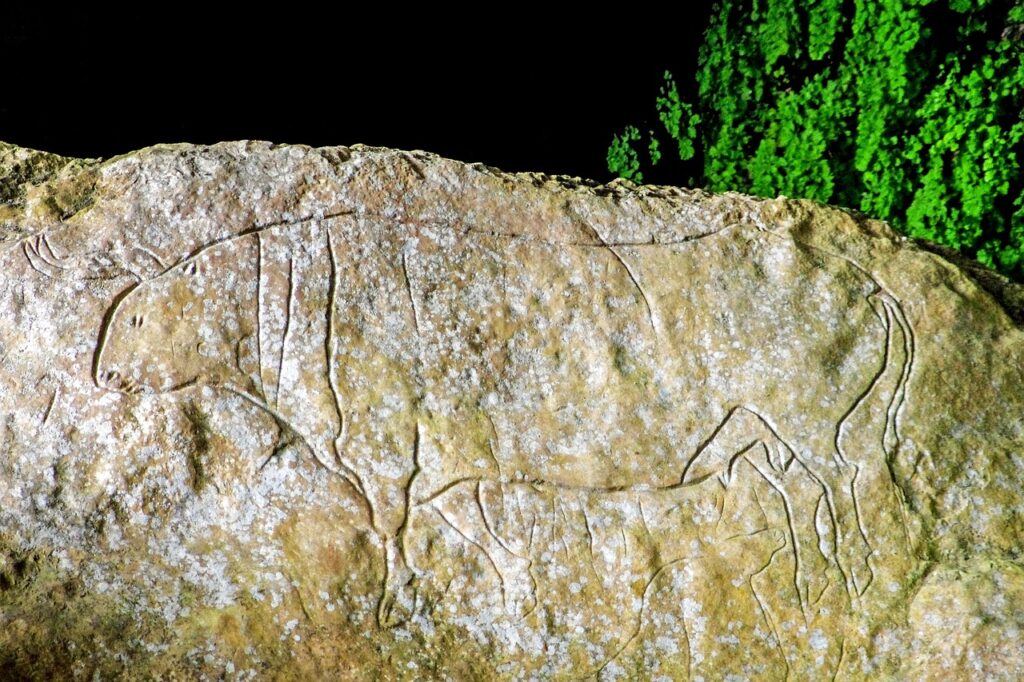
Deep beneath the rolling landscapes of central France, a profound secret lay undisturbed for tens of thousands of years, patiently awaiting discovery. Sealed away by the relentless march of time and the earth’s natural processes, a cave known as La Roche-Cotard held within its chalky walls a silent testament to an intelligence and artistry long underestimated. This wasn’t merely another geological marvel; it was a canvas, etched by hands belonging not to our direct ancestors, Homo sapiens, but to our ancient relatives, the Neanderthals. This remarkable find is not just a glimpse into the past, but a revolutionary re-evaluation of what we thought we knew about early human cognitive abilities. It invites us to peer through the veil of millennia and reconsider the sophisticated inner lives of those who walked the Earth long before us.
The very notion that complex symbolic expression might not be exclusive to Homo sapiens has been a topic of fervent scientific debate for decades. Now, the dramatic revelations emerging from La Roche-Cotard are providing compelling, tangible evidence that adds significant weight to the argument for Neanderthal complexity. This sealed-off sanctuary, nestled overlooking the Loire River, offers an unparalleled window into an ancient world, presenting a challenge to long-held assumptions about the intellectual capacities of these enigmatic hominids. It compels us to ask: what other hidden depths of history lie waiting in the silent chambers of our planet?
As we embark on this journey into the subterranean world, we will first immerse ourselves in the captivating story of La Roche-Cotard, unraveling the scientific detective work that brought its secrets to light. Then, we will broaden our perspective, exploring the fundamental geological forces that craft these very caves, settings for countless stories of life, discovery, and ancient human endeavor. Prepare to be amazed by the sheer majesty and enduring mystery of the Earth’s hidden realms, and the incredible narratives they preserve.

1. **The Enigmatic Discovery of La Roche-Cotard Cave**
The story of La Roche-Cotard is one of serendipity and meticulous scientific inquiry, a narrative stretching from its dramatic re-emergence in the 19th century to the groundbreaking analyses of today. Located on the south-facing slope of the right bank of the Loire, in the commune of Langeais in Indre-et-Loire, France, this hidden space first came to light in 1846. It was a railroad project, carving its way through the landscape, that inadvertently cut through the area, revealing the long-concealed entrance to what would become a site of immense archaeological significance. Early 20th-century digs, specifically in 1912, turned up Mousterian stone tools and animal bones marked with cuts, providing initial hints of ancient occupation, but the true artistic treasures on the walls remained largely overlooked for many decades.
The cave’s remarkable preservation is owed to an extraordinary confluence of natural events. For thousands of years, floods from the Loire River, coupled with relentless wind and numerous landslides, gradually piled up an astonishing accumulation of sediment, ultimately sealing off the entrance completely. Over 30 feet of earth and rock stood as an impenetrable barrier, effectively isolating the cave and its contents from the outside world. This natural blockade ensured that La Roche-Cotard remained untouched and pristine for an astonishing period—somewhere between 57,000 and 75,000 years—a truly immense span of time during which its precious secrets were perfectly preserved.
It wasn’t until starting in 2016 that a dedicated team of researchers began a more intensive and focused investigation of the cave’s interior, shifting attention to the walls themselves. Prior to this, the intricate markings adorning the soft chalk surfaces had been largely ignored or misinterpreted. Through careful and systematic study, utilizing advanced techniques, the team began to discern patterns and forms that suggested something far more deliberate than natural erosion or animal activity. This marked the pivotal moment when the long-sealed cave started to yield its most profound revelations.
The canvas for these ancient artists was a local stone called tuffeau, a soft chalk composed of fine quartz grains and the delicate remnants of ancient mollusc shells. This pliable material proved ideal for drawing, allowing fingers to effortlessly glide and carve, leaving indelible marks that have now endured for millennia. The unique geological composition of the cave walls directly facilitated the creation and preservation of these extraordinary non-figurative engravings, offering a rare glimpse into the expressive world of our ancient relatives.

2. **Unraveling the Mystery of the Engravings**
The journey from observing marks on a cave wall to definitively attributing them to human hands, specifically Neanderthal ones, is a testament to rigorous scientific methodology. Researchers meticulously employed 3D scans of the wall markings, creating detailed digital models that allowed for close examination and comparison. This crucial step enabled them to rule out any newer scratches or marks that might have accumulated over time, and, perhaps most importantly, to clearly differentiate the human-made engravings from natural formations or the tell-tale claw marks left by cave bears or other animals that might have sheltered within. The precise analysis confirmed a deliberate, intentional quality to the lines and dots.
To truly understand who created these marks and when, the team turned to a sophisticated dating technique known as optically stimulated luminescence (OSL) dating. This method is incredibly precise, acting like a geological clock. It works by measuring the last time quartz grains in sediment were exposed to sunlight. When these grains are buried, cosmic radiation accumulates within them. By stimulating them with light in a laboratory, scientists can release this stored energy as luminescence, and the intensity of the light emitted directly indicates how long the grains have been buried and shielded from the sun. It’s an ingenious way to peer back into the deep past.
The application of OSL dating at La Roche-Cotard was comprehensive and illuminating. Researchers collected 50 samples from the layers of sediments both above and surrounding the site where the engravings were found. This extensive sampling allowed them to build a robust chronological framework. The results were astounding: the cavern had been completely sealed off by these accumulating sediments somewhere between 57,000 and 75,000 years ago. This provided a definitive upper age limit for the engravings, firmly placing their creation well before the cave became inaccessible.
This precise dating evidence was nothing short of a game-changer. It established beyond doubt that the markings were created during a period long preceding the arrival of Homo sapiens in this particular region of Europe. This chronological separation instantly eliminated modern humans as potential artists, narrowing the field of authorship dramatically. The clarity of these results underscored the immense antiquity of the engravings and laid the groundwork for attributing them to the only known hominin species present in the area at that time.
3. **Neanderthals as Artists: Challenging the Cognitive Divide**
With the chronological puzzle solved, the scientific spotlight firmly turned to the most likely creators: Neanderthals. The fact that the cave was sealed between 57,000 and 75,000 years ago places the creation of the engravings squarely within the known timeline of Neanderthal presence in Western Europe, and crucially, long before *Homo sapiens* established themselves in this specific part of the continent. This temporal separation serves as a powerful, if indirect, attribution of the art to Neanderthal hands. It forces us to confront the idea that these ancient relatives possessed a capacity for symbolic thought previously often denied to them.
Further bolstering the case for Neanderthal authorship was the presence of Mousterian tools discovered within the cave chambers. Mousterian technology is a distinct type of stone tool assemblage unequivocally associated with Neanderthal populations across Europe and parts of Asia. The exclusive finding of these tools alongside the engravings provides a crucial piece of corroborating evidence. As archaeologist Paul Pettitt of Durham University, an expert not directly involved in the study, observed, all the accumulated evidence “provides strong indirect, cumulative evidence that Neanderthals produced the finger markings.” The convergence of dating and material culture offers a compelling argument.
This groundbreaking discovery profoundly challenges a long-standing “cognitive divide” often drawn between Neanderthals and modern humans. For many years, the ability to create art and engage in symbolic expression was considered a hallmark of *Homo sapiens*, distinguishing us from our extinct cousins. La Roche-Cotard now strongly suggests that this distinction may be far less clear-cut than once believed. The engravings are a powerful indicator that “symbolic expression was not exclusive to Homo sapiens,” opening new avenues for understanding the intellectual and emotional landscapes of Neanderthals.
This evidence forms part of an increasingly accepted school of thought, bolstered by recent archaeological finds, that Neanderthals led far more complex and diverse lives than previously assumed. Studies over recent decades have demonstrated numerous examples of culturally complex activities in Neanderthals, including sophisticated hunting techniques, care for the injured, and even funerary practices. The abstract markings at La Roche-Cotard solidify their place not just as adept tool-makers or resilient survivors, but as beings capable of abstract thought and artistic endeavor, comparable in complexity and diversity to prehistoric members of our own species.

4. **Beyond Figurative Art: The Meaning of Non-Figurative Symbols**
The engravings at La Roche-Cotard are particularly intriguing because they are classified as “non-figurative.” Unlike the vivid animal paintings found in later *Homo sapiens* caves, these markings consist of deliberate lines and dots, abstract shapes traced by fingers across the soft tuffeau walls. While their specific meaning or intent remains unclear to us today, their unambiguous nature as “abstract Neanderthal design” is a significant revelation. They are not random scratches but intentional patterns, suggesting a symbolic purpose, even if that purpose is lost to time.
Determining the intentionality behind these abstract designs was a critical step in the research. The scientists conducted a plotting analysis and utilized photogrammetry to create detailed 3D models of the markings. They compared these with known human markings from other Paleolithic sites, as well as experimental human markings created for study. Based on the “shape, spacing, and arrangement of the engravings,” the meticulous analysis led the team to conclude that the markings were most likely “deliberately produced by human hands in an organized and intentional manner.” This careful assessment ensures that we are indeed looking at art, not accident.
The precise function or meaning these non-figurative symbols held for their Neanderthal creators is a profound mystery that continues to intrigue researchers. Were they territorial markers? Ritualistic symbols? A form of ancient storytelling or communication? Or simply an expression of an aesthetic sensibility, a playful interaction with the cave environment? The absence of a clear narrative or recognizable subject matter means their interpretation is open to various theories, each pushing us to ponder the depths of Neanderthal cognitive processes and cultural practices.
This abstract quality of the La Roche-Cotard engravings stands in contrast to the later figurative art, such as detailed animal murals, that *Homo sapiens* would create. However, it does not diminish their significance; rather, it highlights a different facet of early symbolic expression. These early, seemingly simple marks represent a profound cognitive leap – the ability to create and imbue abstract forms with meaning, a foundational element of human culture. They force us to consider a broader spectrum of what “art” could encompass in the deep past, suggesting that the journey towards complex artistic traditions began with such non-figurative expressions.

5. **A Timeline of Ancient Art: La Roche-Cotard in Context**
The discovery at La Roche-Cotard doesn’t just present a single, isolated finding; it dramatically rewrites portions of the timeline of ancient art, particularly for Neanderthals. Dated to over 57,000 years ago, and potentially as far back as 75,000 years ago through stratigraphic analysis, these engravings instantly claim the title of “the oldest decorated cave in France, if not Europe.” This remarkable antiquity firmly establishes the La Roche-Cotard site as a paramount location in the study of early human symbolic behavior, offering an unprecedented look into the prehistoric artistic landscape of the continent.
Prior to this revelation, the oldest known Neanderthal cave engravings were found in Gorham’s Cave in Gibraltar, dated to approximately 39,000 years ago. While significant in its own right, Gorham’s Cave now takes a secondary position. La Roche-Cotard pushes back the timeline for unambiguous Neanderthal artistic expression by at least 18,000 years, offering a compelling narrative of sustained symbolic engagement within their communities over vast stretches of time. This extended timeline underscores the deep roots of their cognitive capacities.
It’s also fascinating to compare these Neanderthal creations with early *Homo sapiens* art from other parts of the world. For instance, some of the earliest figurative art by modern humans includes the 45,500-year-old pig painting discovered in Indonesia’s Leang Tedongnge cave, or the elaborate animal murals preserved in France’s Chauvet Cave, which are also considerably younger than La Roche-Cotard’s marks. While the styles differ—Neanderthals at La Roche-Cotard produced non-figurative symbols, while early *Homo sapiens* created figurative representations—the discovery points to a parallel, if distinct, development of symbolic thought across different hominin species. Intriguingly, these non-figurative markings are of a similar age to other cave engravings made by *Homo sapiens* in various global locations, suggesting a widespread emergence of symbolic expression.
The accumulating evidence from La Roche-Cotard, combined with other recent findings such as 65,000-year-old pigment-based paintings in Spanish caves attributed to Neanderthals, fundamentally reshapes our understanding. These discoveries suggest that the capacity for symbolic thought and artistic expression was not a sudden emergence unique to *Homo sapiens*, but rather a more broadly distributed trait among different human species. It paints a more nuanced and complex picture of the shared cognitive heritage that connects us all, challenging the notion of a singular path to cultural complexity.
6. **The Geological Genesis of Caves: How Earth Crafts Subterranean Worlds**
The existence of a cave like La Roche-Cotard, capable of preserving such ancient secrets, is a testament to the slow, intricate, and powerful geological processes that continually sculpt our planet. The formation and development of caves, a science known as speleogenesis, is a phenomenon that unfolds over the course of millions of years, a timescale almost unfathomable to the human mind. These natural voids beneath the Earth’s surface, which can range widely in size and complexity, are the product of a remarkable interplay of various forces, each contributing to the creation of these hidden wonders.
The geological processes involved in speleogenesis are diverse and often intertwined. They may encompass a combination of chemical reactions, the relentless erosion by flowing water carrying sediments, the immense power of tectonic forces that crack and shift rock, the subtle yet persistent action of microorganisms, the crushing effects of pressure from overlying rock, and even atmospheric influences like wind. Scientists can even apply isotopic dating techniques to cave sediments, much like at La Roche-Cotard, to determine the exact timescale of the geological events that have formed and shaped present-day caves, unveiling their deep history.
While caves can extend astonishingly deep, there is a theoretical limit to their vertical extent. It is estimated that a cave cannot be more than 3,000 meters (9,800 feet) vertically beneath the surface. This constraint is imposed by the sheer pressure of the overlying rocks, which would cause the material to become plastic and close off any void. However, this vertical limit does not restrict the overall maximum depth of a cave, which is measured from its highest entrance to its lowest point. This broader measurement is dependent on the topography of the landscape above it, allowing for immensely deep systems where the rock burden is distributed horizontally.
The most frequently occurring and often largest caves are solutional caves, also known as karst caves. These magnificent subterranean networks are formed primarily by a chemical reaction between circulating groundwater and soluble bedrock, most commonly limestone, but also chalk, dolomite, marble, salt, and gypsum. The term “karst” itself refers to the distinctive landform created by this process, characterized by a rough and jumbled landscape of bare bedrock ledges, sinkholes, and often a deranged surface drainage where water disappears underground. It’s a landscape sculpted by dissolution, a slow but incredibly powerful force of nature.
Karst landscapes are defined by the removal of bedrock in solution through underground routes, rather than through surface weathering and surface streams. As a result, much karst drainage is internal; rainfall flows into closed depressions and down their drains. This subterranean activity forms continuous conduits that serve as integrated drains for the rapid movement of underground water. The outlets for these water-carrying conduits often manifest as springs of majestic size. Caves are essentially fragments of these vast conduit systems, with some providing access to active streams that carve and reshape their passages, while others are dry relics left behind by waters that have since cut to lower levels, waiting for new discoveries.
7. **Beyond Solutional: Primary and Littoral Caves**
While solutional caves, formed by dissolving soluble rock, are common, Earth’s subterranean landscape is far more varied. Voids can originate from processes as dynamic as volcanic eruptions or as relentless as ocean waves. Caves formed concurrently with surrounding rock are appropriately termed “primary caves,” showcasing an immediate geological birth rather than gradual carving.
The most prevalent primary cave is the “lava tube.” As molten lava flows downhill, its surface cools, solidifying into a crust. Beneath this, hot liquid lava flows, and if most drains away, a hollow conduit remains. These fascinating formations are found globally in volcanic regions; Kazumura Cave in Hawaii, an astonishing 65.6 kilometers long, is a prime example of a deep and extensive lava tube.
Moving to the restless shores, “sea caves,” or littoral caves, are sculpted by ocean waves against coastal cliffs, exploiting inherent weaknesses like faults. Often modest in length, some exceed 300 meters, creating dramatic, wave-cut chambers. Some are now elevated due to geological uplift, while others are submerged solutional caves subjected to littoral erosion, showcasing dynamic land-sea interaction.
8. **The Sculpting Hand: Erosional, Glacier, Fracture, and Talus Caves**
Beyond solutional and primary formations, other powerful forces contribute to Earth’s cave diversity. “Erosional caves” form entirely by abrasive streams carrying rocks and sediments. Unlike solutional caves, they cut through any rock, even granite, guided by zones of weakness. A specialized variant is the “wind” or “aeolian cave,” carved by relentless wind-borne sediments.
Many solutional caves undergo subsequent erosional enlargement when active streams flow through them. In frigid realms, “glacier caves” are born from melting ice and water within and beneath glaciers. These ephemeral wonders are dynamic, shifting under ice pressure. They differ from “ice caves,” which are bedrock caves containing year-round ice formations.
Further, “fracture caves” arise when soluble mineral layers, like gypsum, dissolve between harder rock layers, causing overlying rocks to fracture and collapse. “Talus caves” form from openings among large boulders accumulated in heaps, often at cliff bases. These unstable deposits, known as talus or scree, are prone to frequent rockfalls, making their exploration both perilous and captivating.
9. **The Hidden Oceans: Anchialine Caves and Intricate Physical Patterns**
Among the most captivating subterranean environments are “anchialine caves.” These remarkable coastal caves feature a unique hydrological blend: a mixture of freshwater and saline water, usually seawater. Occurring globally, they often host highly specialized and endemic faunas, uniquely adapted to these brackish conditions. They serve as critical refugia and offer insights into subterranean biodiversity, linking groundwater with the ocean.
Caves also exhibit stunning “physical patterns,” their passages and chambers etched into intricate designs. “Branchwork caves” resemble surface stream networks, with passages joining downstream like tributaries, found near sinkholes. “Angular network caves” arise from intersecting carbonate rock fissures, widened by chemical erosion, forming high, narrow, straight passages in widespread closed loops.
“Anastomotic caves” present a braided appearance, like surface braided streams, with passages separating and reuniting downstream, typically forming along one bed. “Spongework caves” are three-dimensional, random patterns, resembling a sponge, formed when solution cavities merge through mixing chemically diverse waters.
Finally, “ramiform caves” manifest as irregular, large rooms and passages, often from a rising water table eroding carbonate rock with hydrogen-sulfide enriched water. “Pit caves,” or vertical caves, consist of a vertical shaft, serving as dramatic descents into the Earth’s depths.
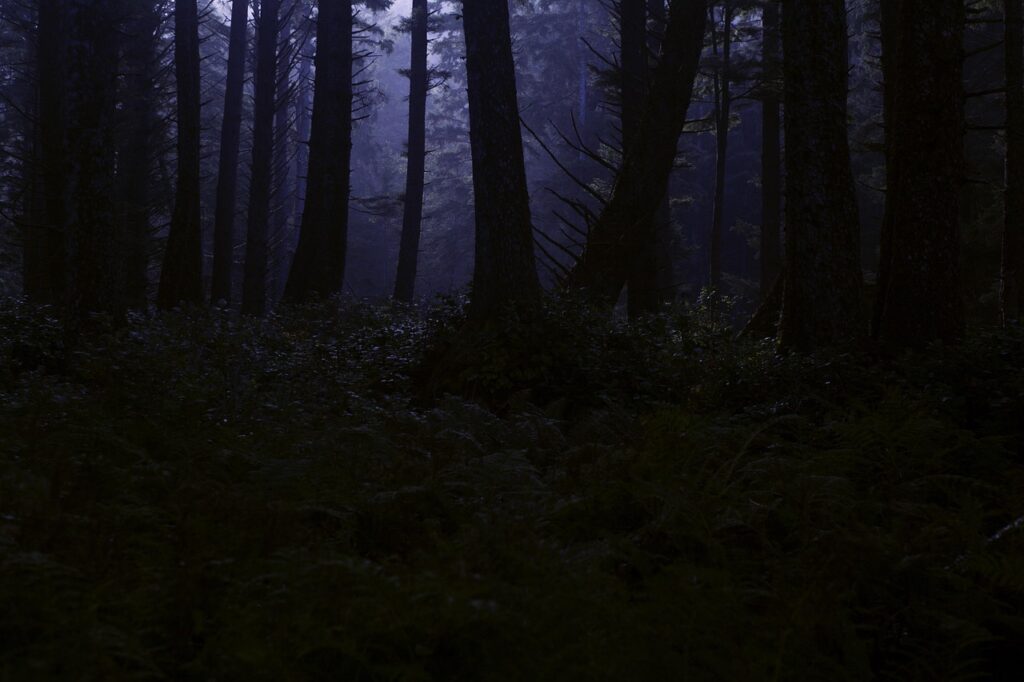
10. **Biospeleology: Life Thriving in Perpetual Darkness**
The perpetual darkness and stable environments of caves foster Earth’s most unique life forms, studied in “biospeleology.” Cave animals are categorized by dependence: “troglobites” are strictly cave-limited; “troglophiles” live in caves and other environments; “trogloxenes” use caves for shelter but complete life cycles outside. Aquatic species have distinct terms: “stygobites,” “stygophiles,” and “stygoxenes.”
Troglobites are arguably the most unusual, showcasing “troglomorphic characteristics” for subterranean life. These often include loss of pigment (pale/white coloration) and reduced or absent eyes. To compensate, troglobites exhibit elongated appendages and enhanced other senses, like acute vibration detection, crucial for navigating and finding food in their lightless world.
Aquatic stygobites, like the endangered Alabama cave shrimp, thrive in subterranean waters, relying on detritus and bat feces. Other examples include cave fish and specialized salamanders like the olm and Texas blind salamander. “Oligaphorura schoetti” is a troglophile insect. “Trogloxenes” like bats (e.g., gray bat) and some cave crickets frequently roost in caves by day, foraging at night.
The isolation and fragility of cave ecosystems make them vital refugia for endangered species, such as the Tooth cave spider and the gray bat. While many surface animals visit caves, these incursions are short-lived. However, cave entrances often boast distinctive flora, like dense populations of the bulblet fern, “Cystopteris bulbifera,” creating a unique biological transition zone.
11. **Caves as Human Sanctuaries: Archaeological and Cultural Significance**
Caves have held profound importance for humanity, serving as shelters, spiritual sites, and repositories of invaluable archaeological records. Earliest human fossils, predating direct habitation, were found in South African caves near Krugersdorp, yielding remains of *Australopithecus africanus*. Their presence there, often due to ancient carnivores, inadvertently preserved them.
However, definitive evidence for hominid habitation dates back at least one million years. *Homo erectus* occupied Zhoukoudian in China, and *Homo neanderthalensis* at Atapuerca in Europe. Early modern humans, starting around 180,000 years ago, utilized sea caves as shelter in southern Africa, exploiting marine resources. This, exemplified by PP13B at Pinnacle Point, may have facilitated rapid human expansion out of Africa.
Across southern Africa, Australia, and Europe, early modern humans transformed caves into canvases for “rock art,” with sites like Giant’s Castle. Beyond art, caves became powerful spiritual spaces. China’s Cave of a Thousand Buddhas and the sacred caves of Crete stand as testaments to their cultural significance. Paleolithic cave paintings, dating back 64,800 years for non-figurative art, offer unparalleled insights into ancient minds and cultures.
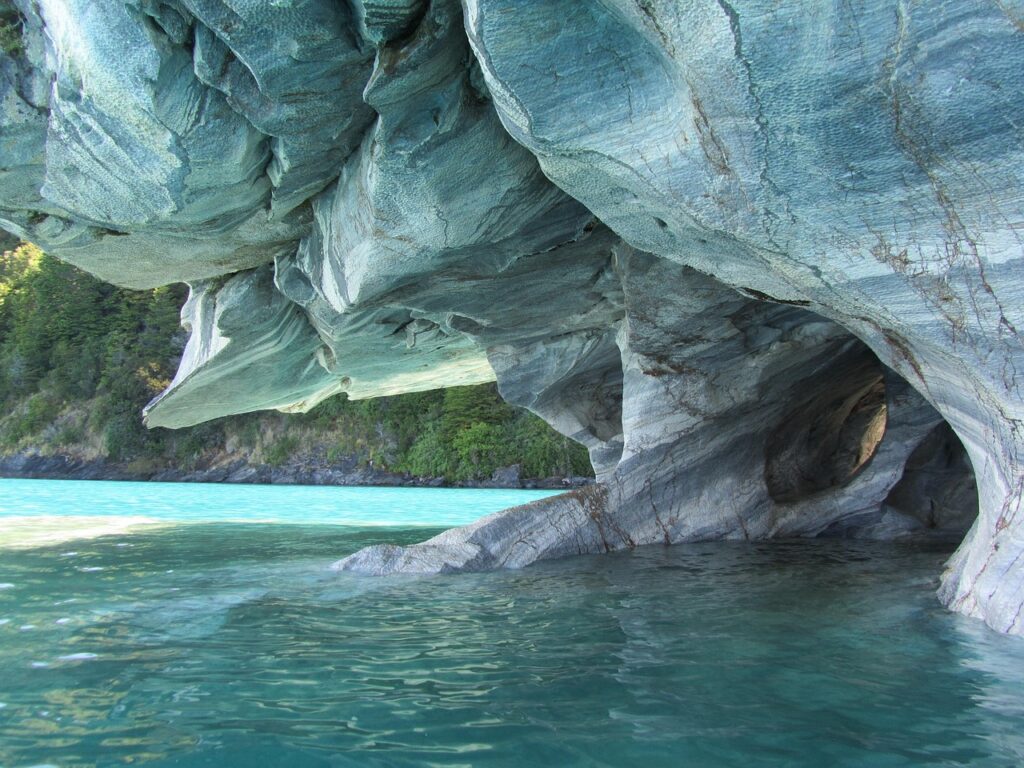
12. **Echoes and Extremes: Cave Acoustics and Record-Breaking Formations**
Caves are ancient amphitheatres, their unique acoustic properties recognized and utilized since prehistoric times. Archaeologists link ancient cave paintings—dots and lines—to specific areas of resonance in Spanish and French caves. This, with Paleolithic instruments, suggests caves were venues for musical events and rituals. Paintings were often in acoustically notable areas, sometimes replicating sounds of depicted animals.
Beyond ancient rituals, the human voice was theorized as an “echolocation device” to navigate dark cave reaches. Dots of red ochre in high-resonance spaces imply a deliberate sound-marking connection. These insights resonate today, with sites like Cumberland Caverns offering superb examples for modern musical uses, valued for reverberation and irregular surfaces. Luray Caverns in Virginia hosts a functioning organ producing sound by mallets striking tuned stalactites.
Finally, we turn to record-breaking extremes. “Mammoth Cave” in Kentucky, USA, is the champion for total surveyed passage length, astounding 675.9 kilometers. For underwater explorers, Mexico’s “Sistema Ox Bel Ha” is the longest at 524.1 kilometers. “Veryovkina Cave” in Abkhazia holds the vertical depth record, plunging 2,204 meters from highest entrance to lowest point. Slovenia’s “Vrtoglavica Cave” boasts the deepest vertical shaft at 603 meters.
Shifting to sheer size, the “Miao Room” in China claims the world’s largest known room by volume, a colossal 10,780,000 cubic meters, while Malaysia’s “Sarawak Chamber” is largest by surface area. Vietnam’s “Son Doong Cave,” with a passage 4.6 km long and over 140m high and wide for parts, hosts the largest passage ever discovered. These superlatives remind us Earth’s hidden worlds continue to astound and inspire.
The journey into Earth’s hidden realms reveals a world far richer and more complex than meets the eye. From ancient engravings challenging our understanding of Neanderthal intelligence to vast subterranean networks sculpted by millennia of geological activity, and from specialized life forms thriving in eternal darkness to resonant chambers that once housed humanity’s earliest art, caves offer an unparalleled tapestry of natural wonder and cultural significance. These silent guardians of history, perpetually evolving and forever waiting to reveal new secrets, remind us of the profound interconnectedness of all life and the enduring mysteries that lie just beneath the surface of our planet. Every dripping stalactite, every echoing chamber, every hidden passage tells a story of time, life, and the astonishing artistry of Earth itself.



